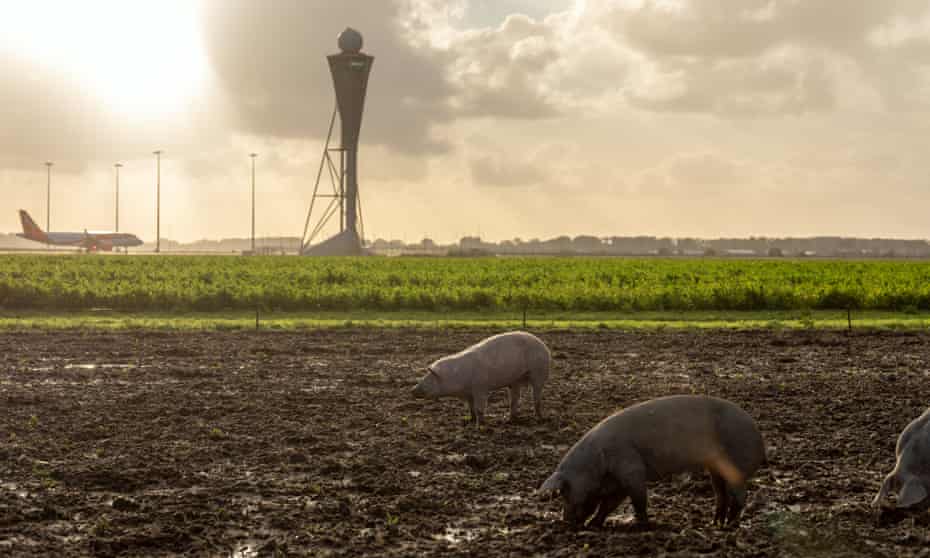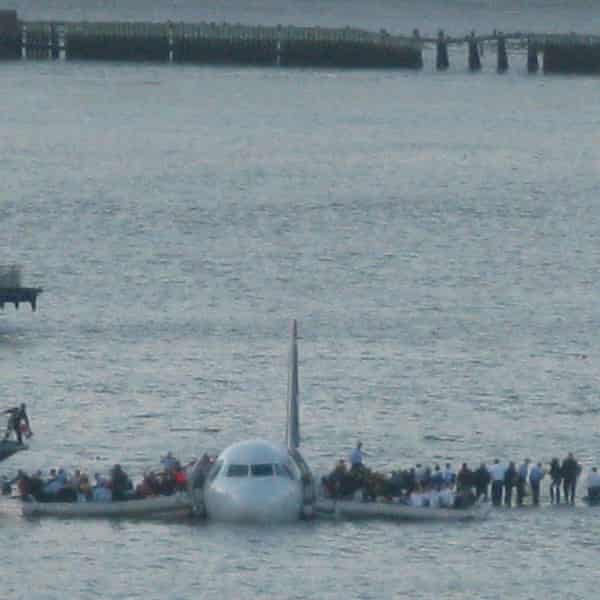Pig patrol: Amsterdam airport’s innovative approach to flight safety

Farm animals are being used to prevent bird strikes as numbers of geese boom around Schiphol, one of Europe’s busiest flight hubs
A group of animals has been drafted in to combat a hazard in the skies above the runways of Amsterdam’s Schiphol airport, the Netherlands’ aviation hub.
A six-week pilot project is studying whether a small herd of pigs can deter flocks of geese and other birds attracted to discarded sugar beet on nearby farmland.
The 19 pigs have been enjoying life on a 2-hectare (5-acre) plot between two runways, turning a field of crop residue into a muddy haven and eating the food that attracts the birds, which can collide with planes and in the worst cases even get sucked into engines.
Two years ago, a KLM Boeing 747 was hit by one such suspected “bird strike”, and had to return to the airport. This was also the cause of the famous US Airways near-disaster in 2009, when both engines lost all power and the captain, Chesley Sullenberger, had to land his stricken Airbus A320 on the Hudson River.
In the year from November 2018, there were 565 strikes near Schiphol, peaking in the summer. The number fell to 259 in 2020-21 as air traffic waned during the coronavirus pandemic.

Ernst Koelman, of the Netherlands’ Human and Transport Environment Inspectorate, said the government regarded every bird strike as a “potential risk” and recorded each incident.
However, long aware of the safety risk, the airport – which is surrounded by natural areas that attract wildlife – has 20 bird controllers tracking avian activity and using technology such as noise and laser beams to deter them.
Stan Gloudemans, co-owner of a small-scale outdoor piggery, Buitengewone Varkens (“extraordinary pigs”), was keen to help when the Royal Schiphol Group, which manages the airport, came to him to see if his animals could do even more.
“Geese like beet, and when it’s left on the fields, they flock to eat it,” he told the Guardian on a visit to the trampled field just west of Amsterdam. “Over there are 30 geese enjoying the beet, but those geese are a danger to aircraft. Here, the pigs have eaten up the beet so the geese stay away.
“This is a trial with two hectares, although the Haarlemmermeer [the district surrounding the airport] is 2,000. I’d dare to say that it’s already a success; next year, on to bigger fields!”
The trial is being run in cooperation with the infrastructure and water management ministry, the agricultural supply agency RVR Loonbedrijf and Buitengewone Varkens, a venture inspired by Portuguese and Spanish pigs that graze on acorns.
“Schiphol came to us as other pigs are mostly in stalls,” said Gloudemans, as he raced to fill troughs with supplementary feed, followed by the surprisingly swift beasts. “All of our pigs are outdoors, we have around 300 a year, and they eat things like nettles, Japanese knotweed for municipalities, and other plants in nature reserves: they like everything. Schiphol asked if they might be able to eat beet and chase away geese.”
Growing numbers of wildfowl in the Netherlands posed a growing challenge for air transport, he said. “There are 10 times as many geese in the Netherlands now as in 1970 – the goose is huge in the Netherlands,” he added.
“Geese are dangerous, but they are animals, and you need to deal with them in the right way. The pig is a double enemy: he tries to catch the geese and he also eats their food. It’s a dual attack.”
Willemeike Koster, a spokesperson for Royal Schiphol Group, said after an “informative” trial period, which had just ended, the airport was considering whether it was feasible to deploy pigs on a larger scale. Referring to the reclaimed land of the area, she said: “Amsterdam Airport Schiphol is located in a polder landscape, with a lot of water, grassy meadows and rich farmland. These factors all contribute to Schiphol being a popular roost for birds. However, birds constitute a risk for aircraft.
“Our first impression is that few geese were spotted in the [pigs’] area. And the pigs did their job by eating the crop residues, which are now gone. All data collected from the bird radar and visual observations, among other things, will be analysed in the coming months.”
Although the noise of planes taxiing and taking off is loud and frequent, there is no evidence that the pigs are bothered, with their tails high and wagging.
Herman Vermeer, a researcher in pig welfare at Wageningen University & Research, said although he had not investigated the effects of noise on outdoor pigs, they were likely to become well adjusted.
“Pigs often need quiet to communicate with each other; for example, with a mother and piglets in a stall, noise can disturb them,” he said. “But in an outdoor situation, pigs are often shocked the first time they hear a noise, but they are also opportunistic and flexible.
“I expect that if they know the noise, they would behave normally, just as there are people who don’t have any problems near a train station or airport,” Vermeer added. “If they are unhappy, they show it like a dog in their tail.”
Sign up for the Animals farmed monthly update to get a roundup of the biggest farming and food stories across the world and keep up with our investigations. You can send us your stories and thoughts at animalsfarmed@theguardian.com